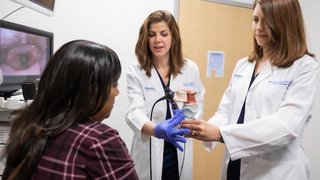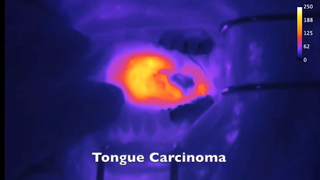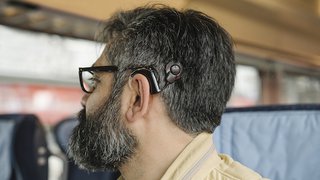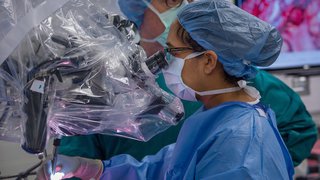Unlocking language for babies who are deaf or hard of hearing
April 29, 2021

Time is language for a baby. Over those first crucial months, the language center in the brain develops in response to external stimuli: a mother's voice, a father's laugh, a slamming door.
Babbling and cooing are signs that a baby is starting to grasp speech. They’re making sounds to mimic the noises around them. “Baby talk” is an indication of normal development of the brain's language center, which generates the ability to communicate with others.
When a baby is born deaf or hard of hearing, the language center cannot respond to sound. Without early identification, a substantial gap can form in the child’s ability to connect words with meaning, and meaning with impact.
Once that gap becomes too great, it becomes exceedingly difficult for a child to gain language comprehension.
The Centers for Disease Control and Prevention (CDC) estimates that nearly 3 of every 1,000 babies born in the U.S. are deaf or hard of hearing. Up to half of these conditions are caused by genetic mutations, and other causes can include environment factors, complications after birth, or infections during pregnancy that may have gone undetected.
Babies who are deaf or hard of hearing need early language acquisition (ELA) and intervention – an approach that supports healthy brain development and gives deaf children vibrant pathways to interact with each other and with the hearing people around them. This is often best achieved by maximizing an infant’s access to early language, which can include both spoken and sign language.
UT Southwestern's Family-Focused Center for Deaf and Hard of Hearing Children connects families with screenings, tests, services, and resources to help children thrive.
Required infant hearing screenings
Like many states, Texas requires hearing tests for all babies born in hospitals and birthing centers. There are two types of non-invasive screenings, which usually are conducted before the baby goes home from the hospital.
Both screenings assess how the tiny hairs in the inner ear transmit vibrations within the cochlea, which transmits vibrations to sound. A functioning cochlea will make its own sound in return, which can be identified by the screening machine. The two standard types of screening are:
- Oto acoustic emissions (OAE): This standard screen plays sounds through a small earphone with a sensor on it. The machine interprets whether the cochlea is functioning as expected. This screen can be done while the baby is asleep or awake, as long as the baby is quiet.
- Automated auditory brainstem response (AABR): This screen assesses more of the auditory pathway up to and including the brainstem and is often done with babies in the neonatal intensive care unit. It introduces a sound into the ear of the sleeping baby, then records activity of a responding brainstem via electrode stickers on their scalp.
In newborns, these screenings are highly specific. However, late onset hearing loss is more common than being born deaf/hard of hearing, so it is possible for hearing loss to develop later in life.
If your baby's results suggest hearing changes, or if you are concerned about their hearing or language development, we will recommend diagnostic testing with an audiologist – a doctor who specializes in hearing.
Ask for audiology testing if your baby doesn't:
- Startle in response to loud noises
- Make noises like their peers or older siblings at that age
- Mimic your sounds when you talk or sing (by three or four months)
- Localize to your voice, or look for you when you speak
- Make single-syllable sounds (by seven months)
Babies who are found to be deaf/hard of hearing do best with immediate intervention to ensure they don't get left behind in language and learning development. My colleagues and I work with families and doctors to intervene as early as we can in care to prevent long-term complications.
Early language access and intervention is key
The purpose of the Family-Focused Center is to provide infants and children with early language access. For infants, hearing loss itself is not what creates challenges. It's the lack of access to an immediate, intact language.
By around age 4, children's brains have completed a substantial amount of a process called myelination, in which a covering slowly develops over the brain's neurons as it matures. Myelination allows for faster and more effective processing of information, but it also makes the brain less “flexible” for developing new pathways. So some activities, such as learning new languages, can become more difficult.
Children who are not granted access to language by that point – often due to delayed identification or insufficient health care access – may never fully close that window of opportunity. They can struggle with communication, which leads to long-term negative effects on their personal and professional lives.
Related reading: What causes hearing loss and how to prevent it
Complex care for children who are deaf or hard of hearing
As part of the ear, nose, and throat program, our team works directly with point-of-diagnosis providers, audiologists, and parents to quickly connect families with the technology, resources, and support they need to give their baby a chance to thrive at home, socially, and in their education.

Our relationships with families often begin by talking parents through the early days of their baby's identification. Using a visual version of their hearing test results (audiogram), we help parents understand how much, if any, their child can access sounds or spoken language.
In my 20+ years doing this work, no family has processed their child's diagnosis the same way. Some families are positive from the start: "What's next? This isn't what we expected, but we're ready for the challenge."
More often, parents need time to grieve over an unexpected diagnosis, and we support families through those difficult times. Many hearing people never imagine their child might be born deaf. And when that most basic expectation is threatened or lost, it can be scary and challenging.
There's no right or wrong way to get from acceptance to action, so long as you focus on doing what's best for your child. Over the next several years of your child's life, we'll guide your family through language development milestones and connecting you with community resources.
Related reading: Cochlear implants for hearing loss: Myths vs. reality
Community resources and education accommodations
The Family-Focused Center routinely refers to Deaf Action Center of Dallas, a community resource that connects kids to deaf mentors and works to eliminate barriers for deaf people at all stages of life. Another exceptional partner is Texas Hands and Voices, which brings together families of kids with hearing disorders in support and camaraderie.
One of the most important connections is special education accommodations through our statewide Early Childhood Intervention program and local education partners. Special education gives kids with medical and/or developmental conditions access to accommodations that help them learn on par with their peers, and alongside them whenever possible.
Your child has a right to educational accommodations under the Individuals with Disabilities Education Act, or Section 504 of the Rehabilitation Act. Every child's learning plan is tailored to their personal needs and goals. Examples of accommodations include:
- Sitting closer to the teacher to see or hear better
- Accessing captioning technology
- Getting written vs. spoken lesson instructions
- Using Bluetooth to connect their hearing aids to their computer, reducing audio distortion
Access to accommodations has been crucial during COVID-19 remote learning. Many students struggled to learn remotely due to poor internet connections and reduced one-on-one interaction. Adding audiological factors on top challenges deaf students further.
However, patients tell us their teachers have gotten creative, discovering new ways to communicate remotely, such as initiating automatic captions on video calls and using microphones to cut room noise during lessons.
Research advances in hearing loss
Right now, researchers are focusing on several areas:
- Language development: Years ago, cochlear implants were not as common as they are now in children. As more data is compiled over time, researchers are finding that getting an implant must be paired with intensive work in spoken language and listening. In other words, getting a successful outcome is not as simple as implanting the device early. It is critical to focus on providing access to language at the "age of acquisition," or the prime time for early language development.
- Function of hair cells in the inner ear: Several institutions are working to determine whether there is a way to change the behavior of malfunctioning hair cells early in life to potentially avoid hearing loss.
Every baby born who is deaf/hard of hearing has a distinct personality and character. Being deaf is not the sole factor that defines them – it's a part of their life and their identity that requires a different approach.
The earlier we can support your deaf or hard of hearing child, the better their chances for successful language development. Language connects us to our world and to each other. Hearing or deaf, connecting through language comprehension opens doors to personal and professional opportunities for the rest of your child's life.











